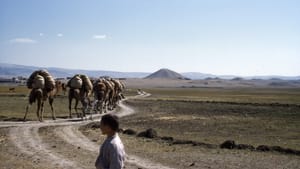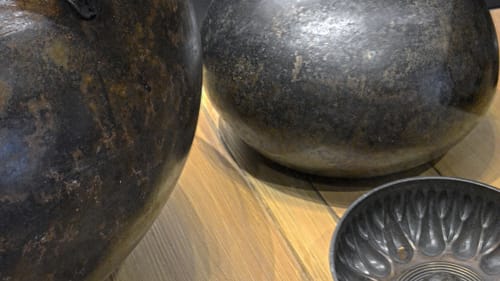Stay in the Loop
BSR publishes on a weekly schedule, with an email newsletter every Wednesday and Thursday morning. There’s no paywall, and subscribing is always free.
Archaeology fit for a king
The Golden Age of King Midas at Penn Museum

Take a deep dive into 2,700-year-old Phrygian culture at The Golden Age of King Midas. This exclusive world premiere exhibition showcases 65 years of Penn’s archaeological exploration of the royal city of Gordion, in what is now central Turkey, which was Midas’s home and an Iron Age cultural nexus for kingdoms throughout the Near East. The majority of the items on exhibit come from four museums in Turkey; most of these have never been seen in the United States.
Midas, who ruled Phrygia from about 740 to 700 BCE, was a real king who lives on in idiom. There’s a factual basis for his golden reputation: Garments in Gordion did shine, thanks to metallurgic compounds used in textile dyes. And though Midas didn’t really turn everything he touched into gold, he was responsible for a golden opportunity for archaeologists in the burial mound (tumulus) he built for his father, King Gordias.
Known as the Midas Mound, the earth-enshrouded tomb is the largest of 124 tumuli set just northeast of Gordion’s citadel and the expansive settlement around it. To the inexperienced eye, tumuli appear to be hills, features of the landscape. This camouflage may have been intentional: The tumulus was constructed from the inside out, centering on a burial chamber of finely crafted wood supported by an external shell of rock and earth. Once sealed after a burial, a tumulus was to remain closed. This lack of external access, along with the naturalistic design, may have foiled potential grave robbers. Much of Penn’s work has focused on excavating 44 of the tumuli, including the 17-story, 1,000 foot diameter Midas Mound erected in 740 BCE.
A 2,700-year-old time capsule
Penn archaeologist Rodney Young initiated the Gordion project in 1950 and spent the next 24 years digging there, discovering nine settlements, built one atop another over 4,000 years. The Midas Mound remained undisturbed until 1957, when careful probing enabled Young to locate and enter the central chamber, finding not only Gordias’s skeleton, but the furnishings and refreshments from the time of the royal interment. Thanks to sensitive excavation and site conservation, the chamber still stands and is now the oldest standing wood structure in the world. “Fortunately, an archaeologist got there before the looters,” notes C. Brian Rose, exhibit curator and director of the Gordion Archaeological Project.

Exhibition visitors can step into an enclosed space for a virtual tour of the chamber as it appeared when mourners said their final goodbyes to Gordias. By rotating a trackball, they can scan the 20-by-23-foot room to see the king in repose in his cedar coffin, surrounded by ornate wood serving tables, bronze bowls, ladles for spooning out lamb and lentil stew, and sipping cups for beverages. This was the funerary feast, reconstructed through chemical analysis of residues found in the serving vessels.
Gordion: a legendary setting
Gordion is known mostly to archaeologists, but the mythology that arose there is widely known. People who know nothing of the Phrygians have heard about the Midas touch — and the associated warning be careful what you wish for — and the Gordian knot.
Common shorthand for the ability to create wealth at will, the Midas, or golden, touch is a wish that quickly became a curse. Having received the ability to turn whatever he touched to gold, Midas quickly regretted the gift, as family members turned to gold. Allowing Midas a do-over, the god Dionysus instructed him to bathe in the Pactoclus River, and the resulting golden residue was deposited downstream at the city of Lydia, which later eclipsed Phrygia as a regional power.
When Greece conquered the area in 333 BCE, Alexander the Great fulfilled the local legend that whomever could release a knot securing an ancient wagon — the Gordian knot — would become ruler of Asia. He couldn’t untie the knot, but slit it with his sword and thus crossed into colloquial fame for cutting the Gordian knot, which now signifies solving an intractable problem.

Though no gold was found in the untouched Midas Mound, Rodney Young did strike gold on his first day at Gordion in 1950, finding beads, bracelets, and other jewelry in a sixth-century BCE burial mound of a young girl. That find foreshadowed what was to come as the site was explored, revealing the ebb and flow of peoples and civilizations who live on in literature and language.
The threat of extremists
The work at Gordion continues as antiquities across the Near East come under increasing threat from extremists annihilating the history of those they would dominate. “We are more conscious of the fragility of the heritage of the Near East,” says the Gordion project’s Rose. “I would encourage people to write to anyone who can make preservation of cultural heritage part of the international discourse.”
As Rodney Young did, let’s hope the archaeologists stay one step ahead of those who would destroy the region’s cultural heart.
What, When, Where
The Golden Age of King Midas, February 13 through November 27, 2016. Penn Museum, 3260 South Street, Philadelphia. 215-898-4000 or penn.museum
On weekends in February and March, the museum’s Pepper Mill Café will feature Turkish specialties such as lamb stuffed eggplant and stuffed grape leaves, as well as Midas Touch beer, a recreation of a wine-beer-honey mead beverage developed by Dogfish Head Brewery and Penn Museum’s Biomolecular Archaeology Project.
Talks, tours, and other public programs related to Midas, Gordion, and Turkish culture will be offered throughout the exhibition.
Sign up for our newsletter
All of the week's new articles, all in one place. Sign up for the free weekly BSR newsletters, and don't miss a conversation.
